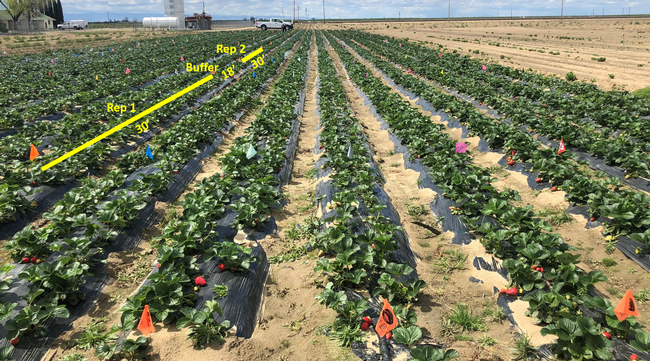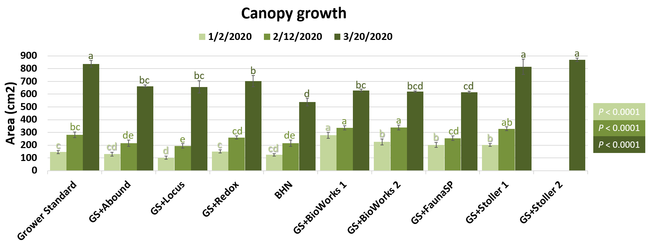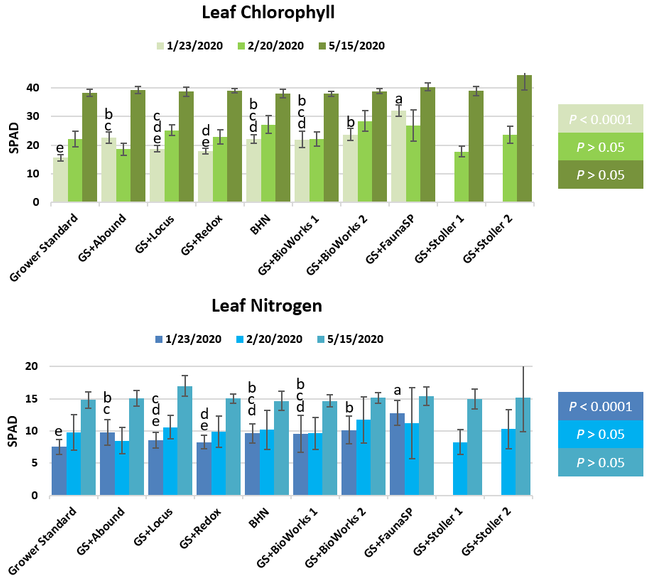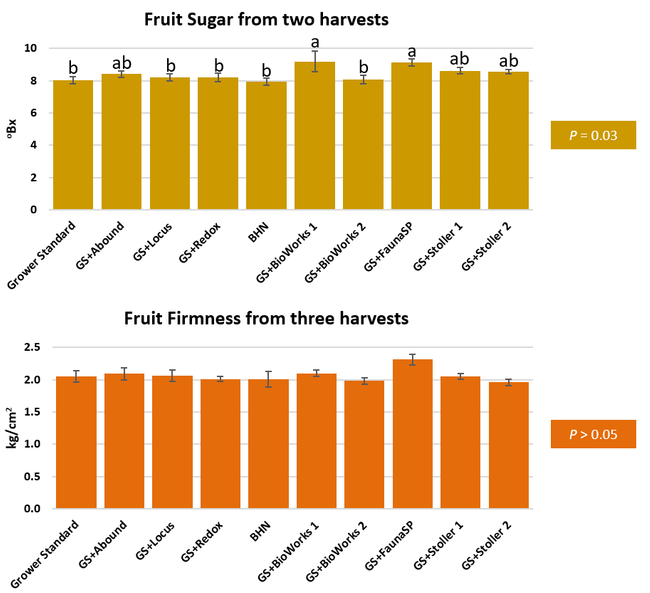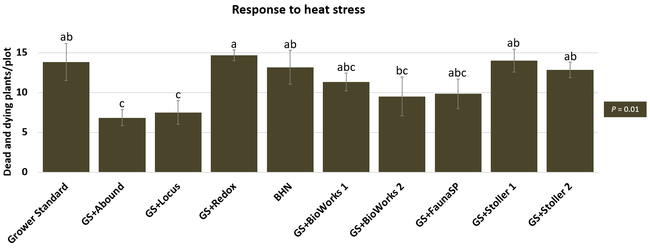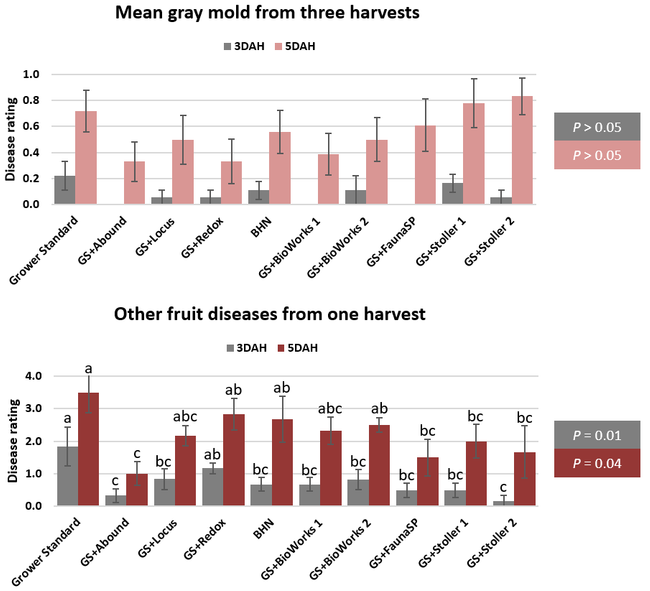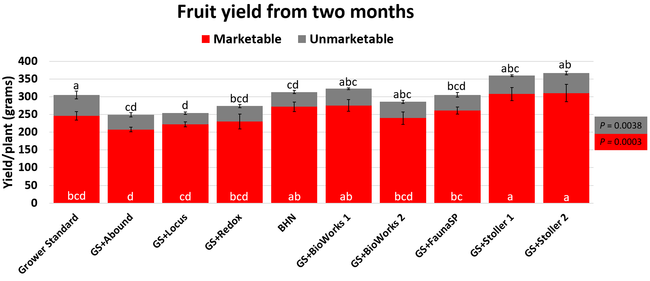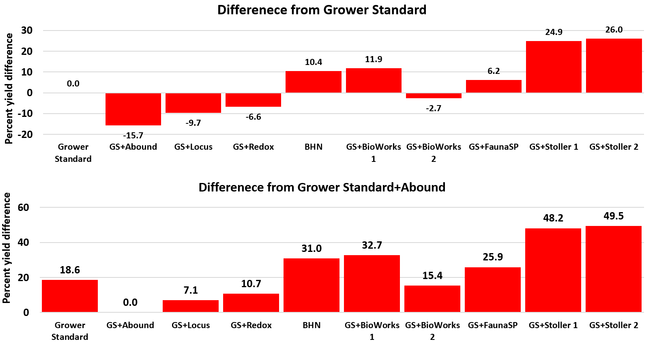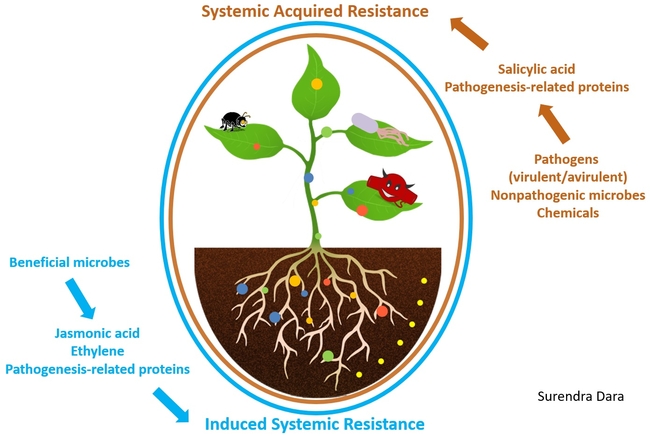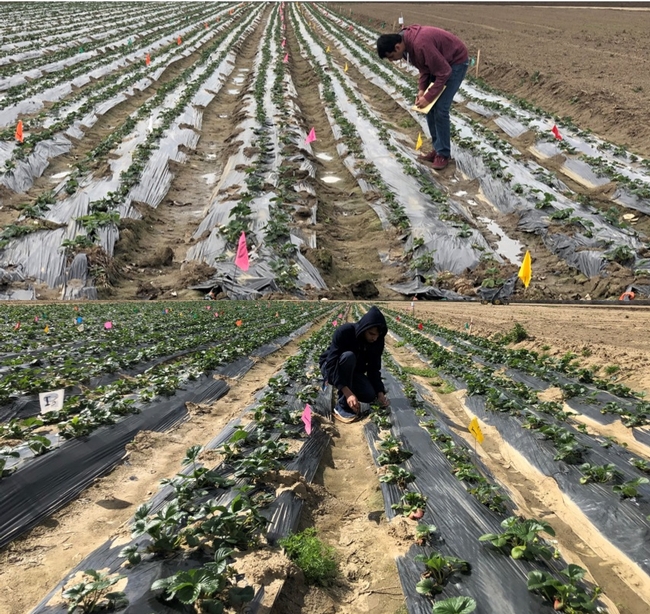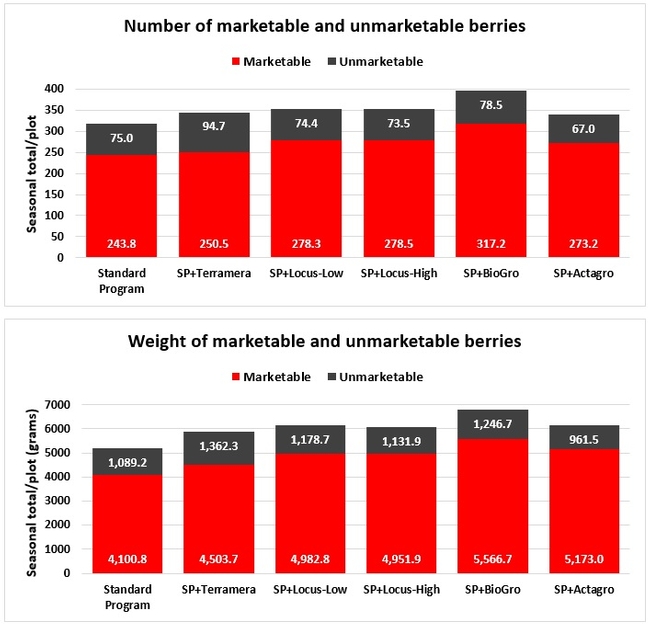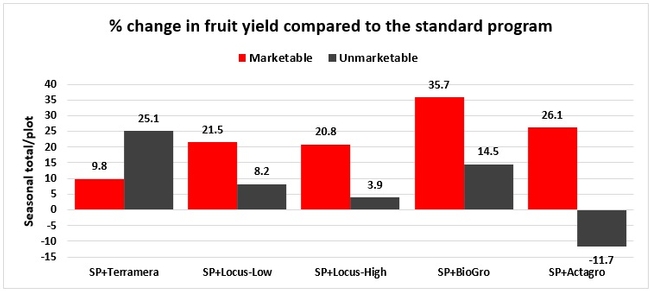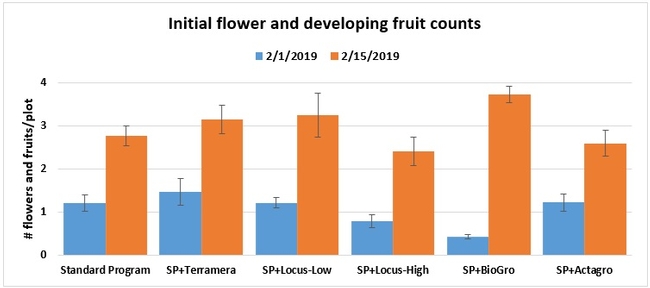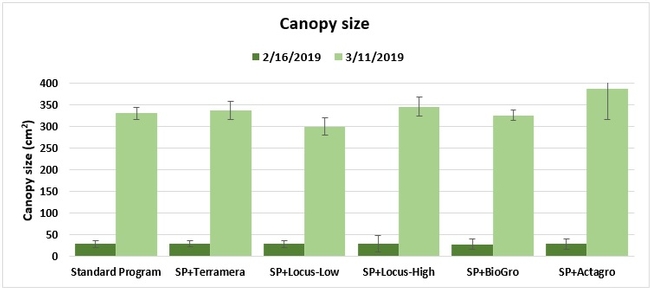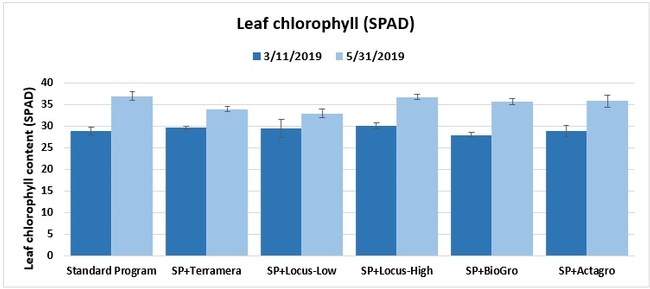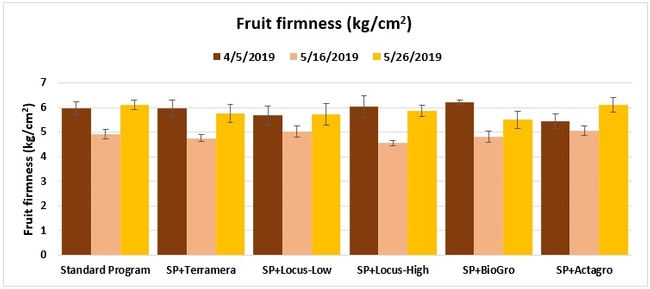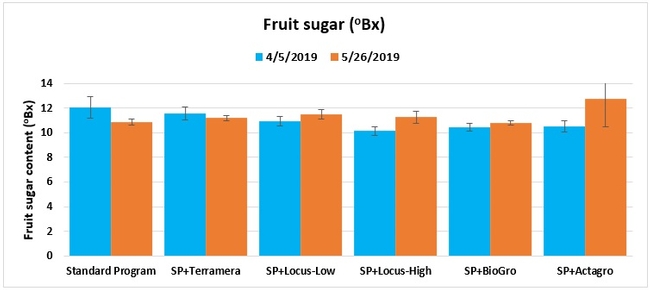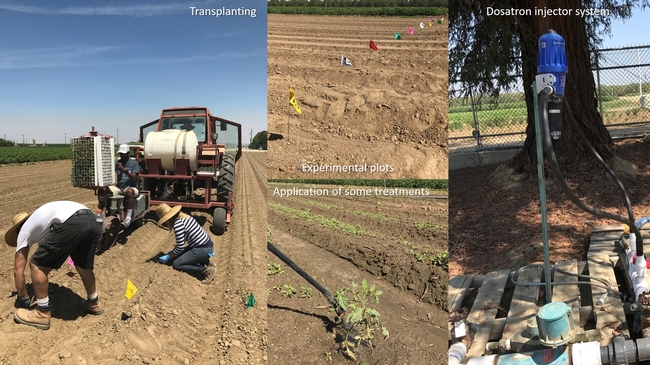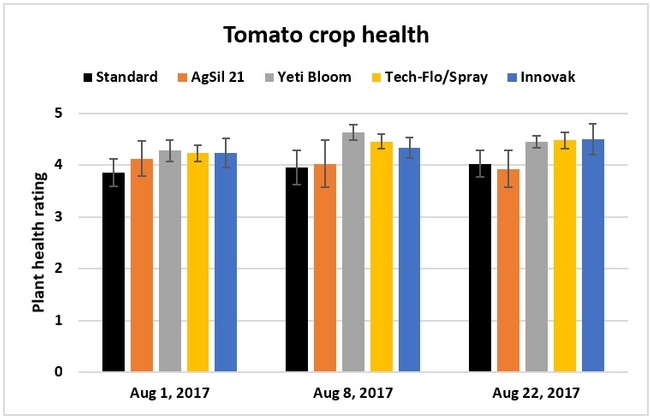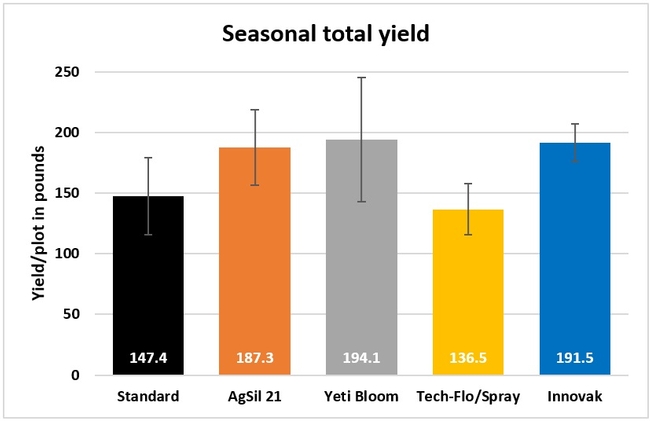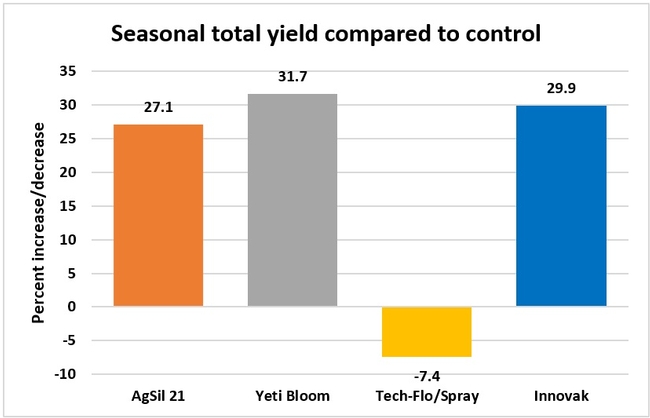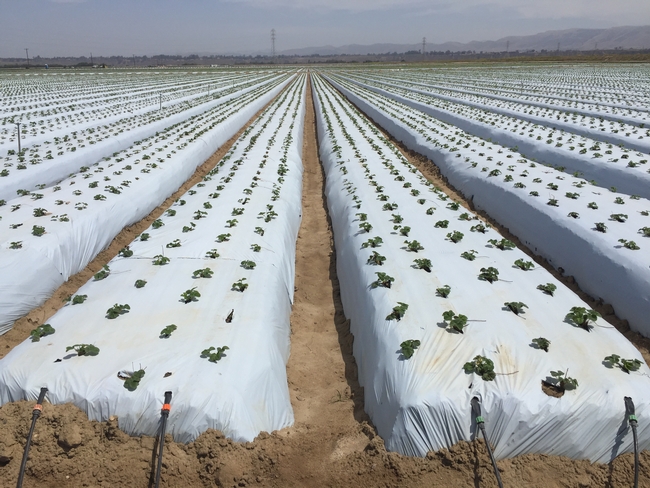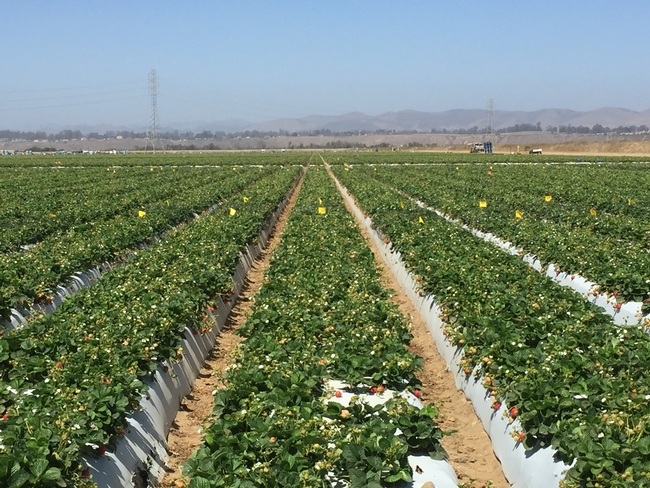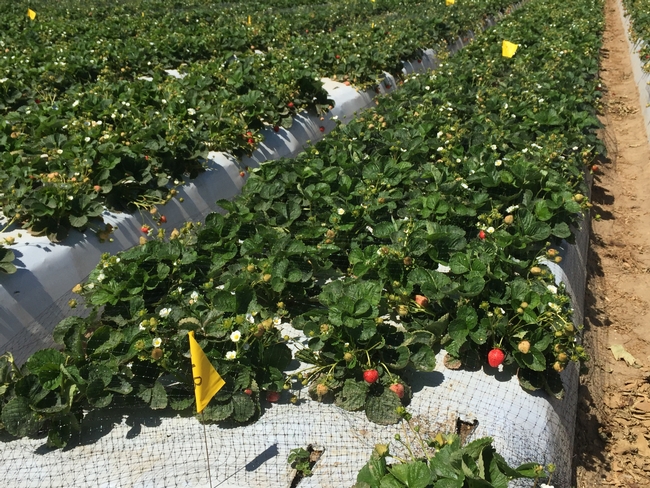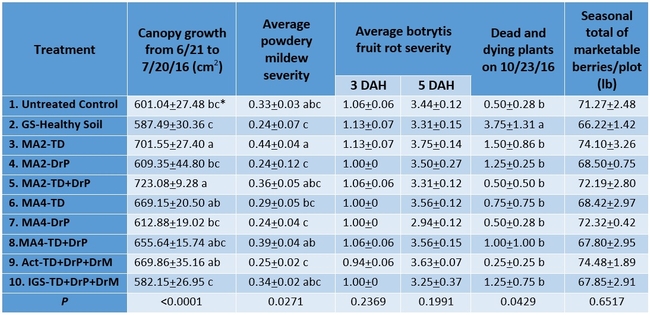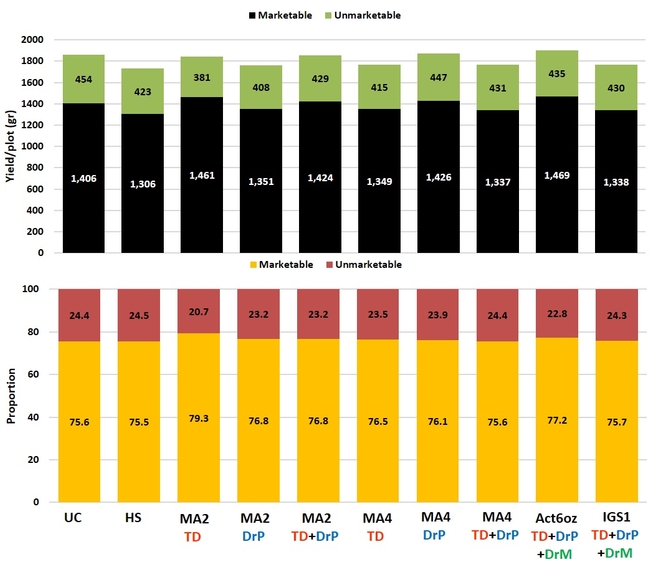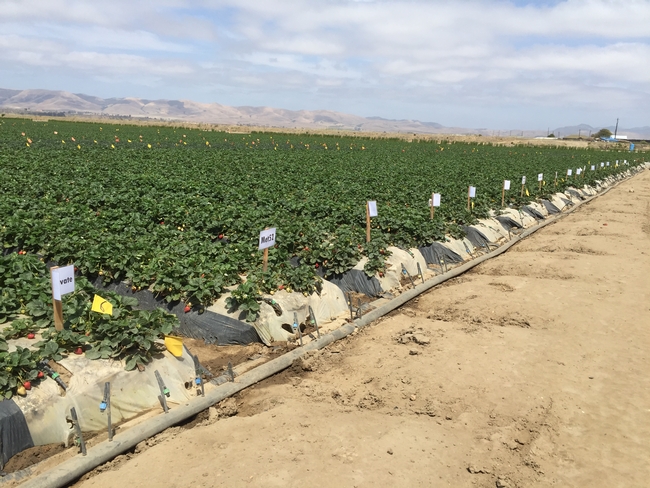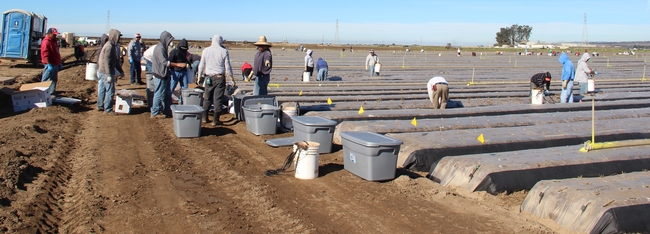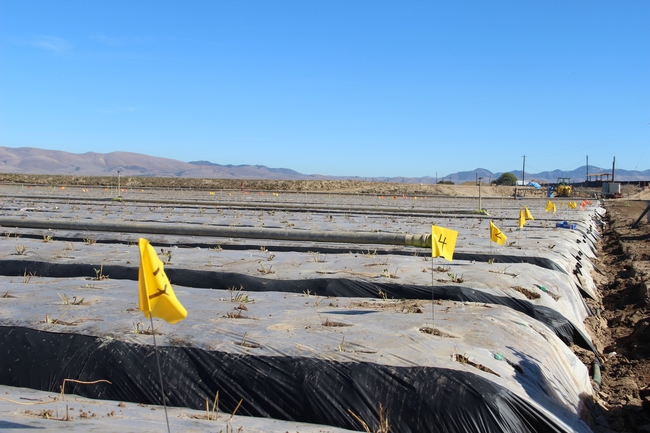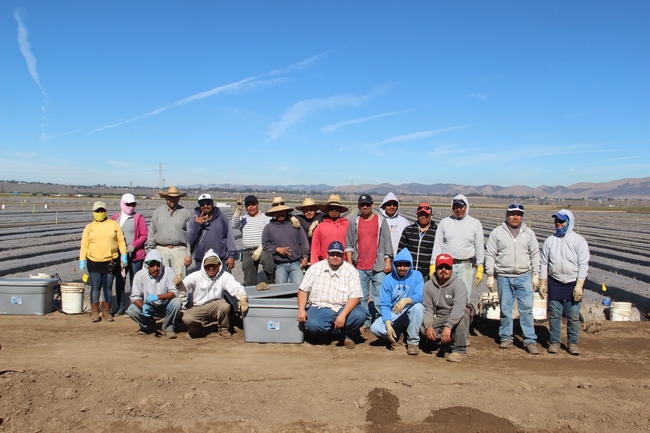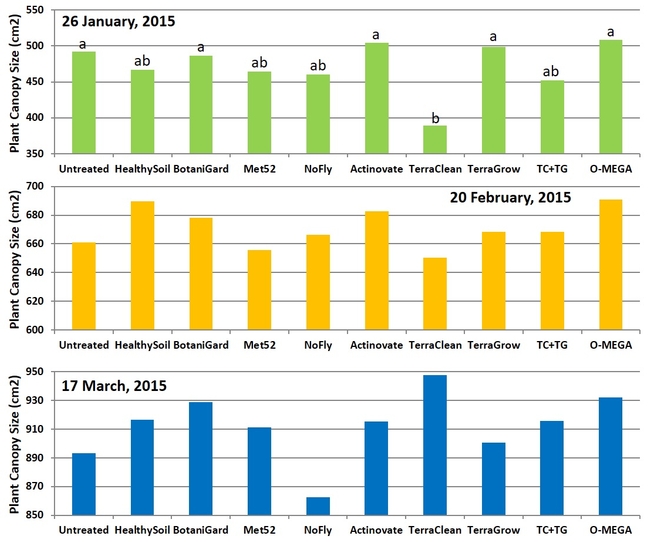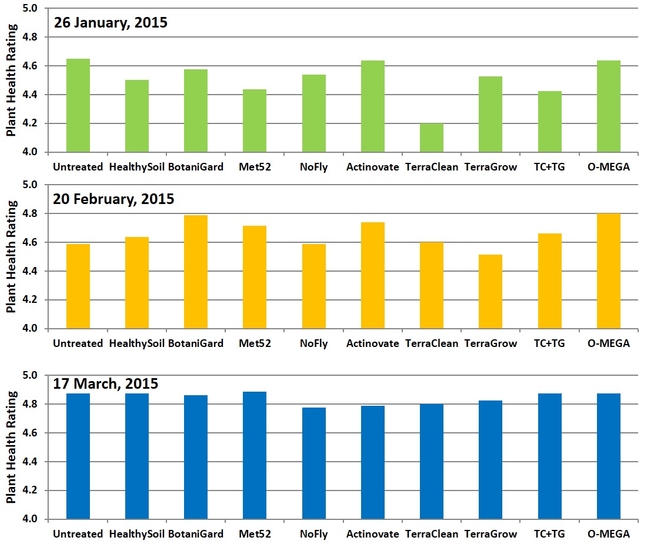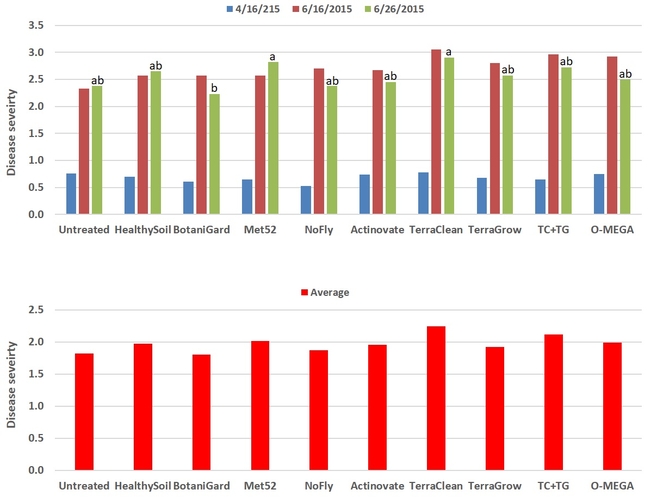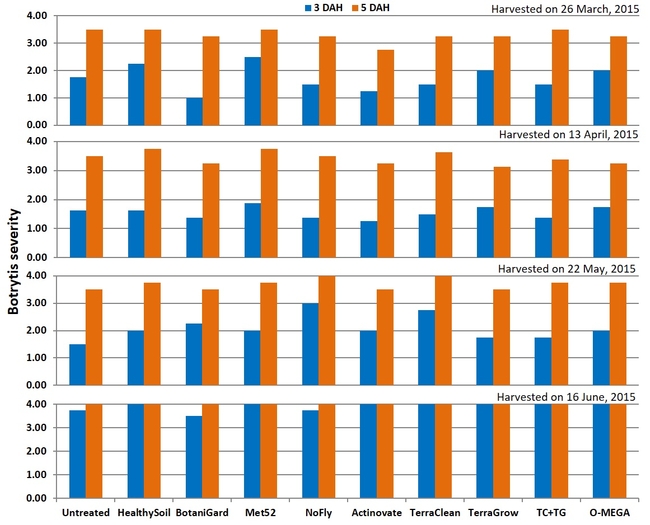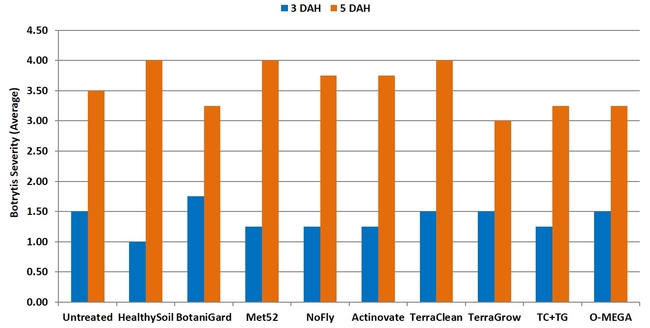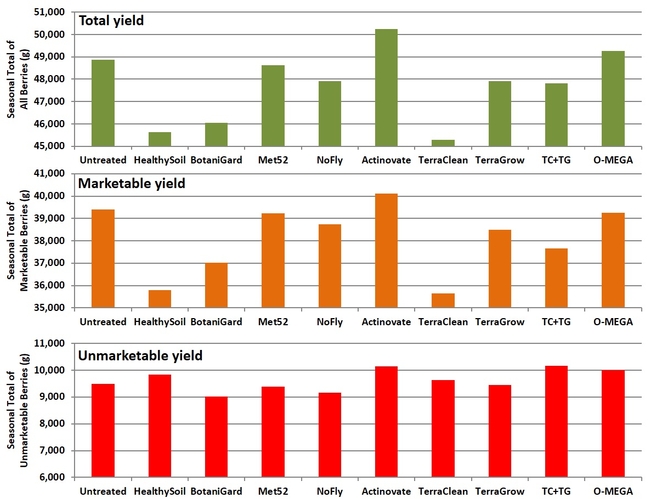- Author: Surendra K. Dara
Balanced nutrient inputs are essential for optimal plant growth and yields. Depending on the soil, crop, and environmental conditions, certain nutritional supplements further enhance crop performance. While macro- and micro-nutrients are necessary for plant growth and optimal yields, biostimulants play multiple roles by increasing the bioavailability of nutrients, improving nutrient and water absorption, protecting plants from pestiferous organisms either through direct antagonism or by triggering plants defense mechanisms (Berg, 2009; Dara, 2019a). In addition to improving health and yields, biostimulants are also known to increase nutritional quality (Parađiković et al., 2011; Fierentino et al., 2018). Multiple field studies in California demonstrated the potential of biostimulants and soil amendments in improving yields in tomato (Dara, 2019b; Dara and Lewis, 2019) and strawberry (Dara and Peck, 2018; Dara, 2019a). As the knowledge of biostimulants and their potential for sustainable agriculture is expanding, there has been a steady introduction of biostimulant products in the market warranting additional studies. A study was conducted to evaluate the potential of different biostimulant materials on strawberry growth, health, and fruit yields.
Methodology
This study was conducted in an experimental strawberry field at the Shafter Research Station during 2019-2020. Cultivar San Andreas was planted on 29 October 2019. No pre-plant fertilizer application was made in this non-fumigated field which had both Fusarium oxysporum and Macrophomina phaseolina infections in previous year's strawberry planting. Each treatment was applied to a 300' long bed with single drip tape in the center and two rows of strawberry plants. Sprinkler irrigation was provided immediately after planting along with drip irrigation, which was provided one or more times weekly as needed for the rest of the experimental period. Each bed was divided into six 30' long plots, representing replications, with an 18' buffer in between. This study included both biostimulant and nutrient supplements, but this article presents data from the biostimulant treatments only. Treatments were applied either as fertigation through the drip system using a Dosatron or sprayed over the plants with a handheld garden sprayer. The following treatments were evaluated in this study:
i) Grower Standard (GS): Between 6 November 2019 and 9 May 2020, 1.88 qt of 20-10-0 (a combination of 32-0-0 urea ammonium nitrate and 10-34-0 ammonium phosphate) and 1.32 qt of potassium thiosulfate was applied 20 times at weekly intervals through fertigation. This fertilizer program was used as the standard for all treatments except for the addition of biostimulant materials.
ii) GS + Abound: Transplants were dipped in 7 fl oz of Abound (azoxystrobin) fungicide in 100 gal of water for 4 min immediately prior to planting. Transplant dip in a fungicide is practiced by several growers to protect from fungal diseases and is considered as another standard in this study.
iii) GS + Locus program: Applied Str10 (Wickerhamomyces sp.) at 5 fl oz/ac with molasses at 10 fl oz/ac immediately after planting and Rhizolizer (Trichoderma harzianum and Bacillus amyloliquefaciens) at 3 fl oz with a food source blend at 10 fl oz 2 weeks after Str10 application through the drip system. Repeated the same pattern starting from mid-February 2020. From February to May, applied 6 fl oz/ac of Rhizolizer with 20 fl oz/ac of food source once a month. Str10 is an unregistered product with yeast that is expected to help with nutrient uptake and phosphorous mobilization for improved plant vigor and yield. Rhizolizer is expected to solubilize soil nutrients and improve crop growth and yield.
iv) GS + Redox program: Starting from about one month after planting, diKaP (0-31-50 NPK) was applied as a foliar spray at 2 lb in 50 gpa every two weeks. In addition to potassium and phosphorus, diKaP also contains proprietary soluable carbon compounds that improve antioxidant production leading to increased plant respiration and tolerance to abiotic stress.
v) Bio Huma Netics (BHN) program: Transplants were dipped in 10 gal of water with 6.4 fl oz of BreakOut (4-14-2 NPK), 1.28 fl oz of Promax (thyme oil), 1.28 fl oz of Vitol (8-16-4 NPK with iron, manganese, sulfur, and zinc), and 1.28 fl oz of Zap (8-0-0 N with iron, manganese, sulfur and zinc) for 4 min immediately prior to planting. Custom blends of macro- and micro-nutrients (Ultra Precision A and B) were prepared based on soil (pre-planting) and plant tissue analyses and applied as a substitute to the grower standard fertility program. Ultra Precision A during the first 30 days after planting and Ultra Precision B for the rest of the study period were applied at weekly intervals at 1.6 gal/bed for a total of 12 times (compared to 20 fertigation events for the grower standard program). Ultra Precision blends were made with Super Phos/Phos-Max, Super Potassium, X-Tend, Nitric acid, Calcium, 44 Mag, BreakOut, Vitol, Max Pak, Iro-Max, Activol, Comol, and Surf-Max that provided N, P, and K along with boron, calcium, cobalt, copper, iron, magnesium, manganese, molybdenum, and sulfur.
vi) GS + BioWorks program 1: Applied 32 fl oz of ON-Gard (based on soy protein hydrolysate) every two weeks through the drip system from planting until canopy develops and then applied as a foliar spray in 50 gpa. ON-Gard is expected to increase the nutrient use efficiency and decrease abiotic stress to the plants.
vii) GS + BioWorks program 2: Applied 32 fl oz of ON-Gard (soy protein-based) every two weeks through the drip system from planting until canopy develops and then sprayed in 50 gpa. Also applied RootShield Plus WP (T. harzianum and T. virens) at 2 lb/ac through drip immediately after planting and 1 lb/ac at the end of November and again at the end of December 2019. RootShield is a biofungicide expected to protect strawberry from phytopathogens and improve water and nutrient uptake.
viii) GS + Fauna Soil Production (FSP) program: Applied CropSignal at 10 gpa six days prior to planting and at 5 gpa 30 after transplanting through the drip system. CropSignal is a carbon-based nutrient formula containing botanical extracts and along with cobalt, copper, manganese, and zinc and is expected to support the growth and diversity of beneficial aerobic soil microbes for improved soil structure, water retention, nutrient cycling, and plant protection.
ix) GS + Stoller program 1: Applied Stoller Root Feed Dry (9-0-5 NPK with boron, calcium, magnesium, and molybdenum) at 10 lb/ac every 10 days starting from 19 February 2020 and Stoller Grow (4-0-3 NPK with copper, magnesium, manganese, and zinc) at 8 fl oz/ac once on 27 February 2020 through the drip system. Stoller Root Feed Dry is expected to promote continuous root growth by maintaining nutritional balance while Stoller Grow is expected to increase growth efficiency and abiotic stress tolerance.
x) GS + Stoller program 2: Applied Harvest More Urea Mate (5-10-27 NPK with boron, calcium, cobalt, copper, magnesium, manganese, molybdenum, and zinc) at 10 lb/ac along with Stoller Crop Mix (algal extract with boron and calcium) at 8 fl oz/ac every 10 days starting from 19 February 2020 and Stoller Grow at 8 fl oz/ac once on 27 February 2020 through the drip system. Harvest More Urea Mate is expected to provide optimal plant growth while Stoller Crop Mix is expected to maintain the nutritional balance and improve crop vigor and yields.
Parameters observed during the study included canopy growth (area of the canopy) in January, February, and March; first flower and fruit count in January; leaf chlorophyll and leaf nitrogen (with chlorophyll meter) in January, February, and May; fruit sugar (with refractometer) in March and May; fruit firmness (with penetrometer) in March, April, and May; severity of gray mold (caused by Botrytis cinereae) and other fruit diseases (mucor fruit rot caused by Mucor spp. and Rhizopus fruit rot caused by Rhizopus spp.) 3 and 5 days after harvest (on a scale of 0 to 4 where 0=no infection; 1=1-25%, 2=26-50%, 3=51-75% and 4=76-100% fungal growth) in March and May; sensitivity to heat stress (expressed as the number of dead and dying plants) in May; and fruit yield per plant from 11 weekly harvests between 11 March and 14 May 2020. Data were analyzed using analysis of variance in Statistix software and significant means were separated using the Least Significant Difference test.
Results and Discussion
The impact of treatments varied on various measured parameters. The interactions among plants, available nutrients, beneficial and pathogenic microorganisms in the crop environment, the influence of environmental factors, and how all these biotic and abiotic factors ultimately impact the crop health and yields are very complex. The scope of this study was only to measure the impact of biostimulants and nutrient supplements on growth, health, and yield parameters and not to investigate those complex interactions.
The canopy size does not always correspond with yields but could be indicative of stresses and how the plant is responding to them in the presence of treatment materials. Plants in some treatments had significantly larger canopy size in January and February, but plants in the grower standard and both Stoller programs were significantly larger than the rest by March. Leaf chlorophyll and nitrogen contents were significantly different among treatments only in January where the grower standard plants had the lowest and the plants that received CropSignal had the highest. When the counts of the first onset of flowers and developing fruits were taken in January, plants that received the BioWorks program that only received ON-Gard had the highest number followed by the CropSignal and Abound treatments. Stoller treatments were not included in the study at this time, so data for leaf chlorophyll, nitrogen, and first flower and fruit counts were not available in January. Average fruit sugar was the highest in BioWorks program with ON-Gard alone followed by FSP's Crop Signal, both Stoller programs, and the Abound treatments. There was no statistically significant difference in the average fruit firmness among the treatments. Severity of the gray mold, which occurred at low levels during the observation period, also did not statistically differ among the treatments. However, the severity of other diseases was significantly different among various treatments with the highest level in fruits from the grower standard. Temperatures were unusually high during the last week of May and several plants exhibited heat stress and started to die. The number of dead or dying plants on 28 May was the lowest in Locus and Abound treatments.
There were significant differences in marketable and unmarketable fruit yields among treatments. Highest marketable yields were seen in both Stoller treatments followed by BioWorks program with ON-Gard alone, BHN, and other treatments. Transplant dip in a fungicide seems to have a negative impact on fruit yields as observed in the current study or earlier studies (Dara and Peck, 2017 and 2018; Peck unpublished data). While the grower standard had the highest amount of unmarketable fruits, the Locus treatment had the lowest in this study. Fruit yield and some of the observed parameters appeared to be better in the grower standard compared to some treatments, which has also been seen in some earlier strawberry studies. While biostimulants can help plants under some stresses, providing sufficient macro- and micro-nutrients seems to be critical for higher fruit yields as seen with Stoller and BHN treatments. It is important to note that BHN materials were applied only 12 times compared to 20 applications of the grower standard treatment or other treatments that were applied on top of the grower standard treatment. It is also important to note that when ON-Gard was used alone, it also improved the marketable fruit yields by nearly 12% compared to the grower standard. When marketable fruit yield in the Abound treatment was considered, all treatments performed better 7-50% higher yields. Sometimes natural balance of the nutrients, organic matter, and microbial community in the soil might result in optimal yields in the absence of pathogens or other stressors. However, it is very common to use fungicidal treatments or add biological or supplemental nutrition to protect from potential threats and improving yields. These results help understand the impact of various biostimulants and supplements and warrant the need to continue such studies under various environmental, crop, and soil conditions.
Acknowledgments: Thanks to Bio Huma Netics, BioWorks, Inc., Fauna Soil Production, Locus Agricultural Solutions, Redox Ag, and Stoller for the financial support of the study and Marjan Heidarian Dehkordi and Tamas Zold for their technical assistance.
References
Berg, G. 2009. Plant-microbe interactions promoting plant growth and health: perspectives for controlled use of microorganisms in agriculture. Appl. Microbiol. Biotechnol. 84: 11-18.
Dara, S. K. 2019a. Improving strawberry yields with biostimulants: a 2018-2019 study. UCANR eJournal of Entomology and Biologicals. https://ucanr.edu/blogs/blogcore/postdetail.cfm?postnum=31096
Dara, S. K. 2019b. Effect of microbial and botanical biostimulants with nutrients on tomato yield. CAPCA Adviser, 22(5): 40-45.
Dara, S. K. and D. Peck. 2017. Evaluating beneficial microbe-based products for their impact on strawberry plant growth, health, and fruit yield. UCANR eJournal of Entomology and Biologicals. https://ucanr.edu/blogs/blogcore/postdetail.cfm?postnum=25122
Dara, S. K. and D. Peck. 2018. Evaluation of additive, soil amendment, and biostimulant products in Santa Maria strawberry. CAPCA Adviser, 21 (5): 44-50.
Dara, S. K. and E. Lewis. 2019. Evaluating biostimulant and nutrient inputs to improve tomato yields and crop health. Progressive Crop Consultant 4(5): 38-42.
Fiorentino, N., V. Ventorino, S. L. Woo, O. Pepe, A. De Rosa, L. Gioia, I. Romano, N. Lombardi, M. Napolitano, G. Colla, and Y. Rouphael. 2018. Trichoderma-based biostimulants modulate rhizosphere microbial populations and improve N uptake efficiency, yield, and nutritional quality of leafy vegetables. Frontiers in Plant Sci. 9: 743.
Parađiković, N., T. Vinković, I. V. Vrček, I. Žuntar, M. Bojić, and M. Medić-Šarić. 2011. Effect of natural biostimulants on yield and nutritional quality: an example of sweet yellow pepper (Capsicum annuum L.) plants. J. Sci. Food. Agric. 91: 2146-2152.
- Author: Surendra K. Dara
Biostimulants are beneficial microorganisms or substances that can be used in crop production to improve plants' immune responses and their ability to perform well under biotic and abiotic stresses. Biostimulants induce plant resistance to stress factors through systemic acquired resistance or induced systemic resistance. When plants are exposed to virulent and avirulent pathogens, non-pathogenic microorganisms, and some chemicals, the systemic acquired resistance mechanism is activated through the salicylic acid pathway triggering the production of pathogenesis-related proteins. On the other hand, when plants are exposed to beneficial microbes, the induced systemic resistance mechanism is activated through the jasmonic acid and ethylene pathways. The jasmonic acid pathway also leads to pathogenesis-related protein production in plants. In other words, when plants are exposed to pathogens, non-pathogens, or other compounds, various defense genes are activated through two major immune responses, helping plants fight the real infection or prepare them for potential infection. Beneficial microbes and non-microbial biostimulants are like vaccines that prepare plants for potential health problems.
Earlier studies in tomato (Dara and Lewis, 2018; Dara, 2019a) and strawberry (Dara and Peck, 2018; Dara, 2019b) demonstrated varying levels of benefits to crop health and yield improvements from a variety of botanical, microbial, or mineral biostimulants and other supplements. Some of the evaluated products resulted in significant yield improvement in both tomatoes and strawberries compared to the grower standard practices. There are several biostimulant products in the market with a variety of active ingredients, and some also have major plant nutrients such as nitrogen, phosphorus, and potassium. Depending on the crop, growing conditions, potential risk of pests and diseases, and other factors, growers can use one or more of these products. A study was conducted to evaluate the impact of various biostimulants on the yield, quality, and shelf life of strawberries.
Methodology
Strawberry cultivar San Andreas was planted late November 2018 and treatments were administered at the time of planting or soon after, depending on the protocol. Each treatment had a 290' long strawberry bed where 10' of the bed at each end was left out as a buffer. Then, six 30' long plots, each representing a replication, were marked within each bed with an 18' buffer between the plots. Since the test products needed to be applied through the drip system, an entire bed was allocated for each treatment, except for the standard program that had one bed on either side of the experimental block, and plots were marked within each bed for data collection. The following treatment regimens were used in the study:
1. Standard Program (SP): Major nutrients were provided in the form of Urea Ammonium Nitrate Solution 32-0-0, Ammonium Polyphosphate Solution, and Potassium Thiosulfate (KTS 0-0-25). Nitrogen, phosphorus, and potassium were applied before planting in November 2018 at 170, 60, and 130 lb/acre, respectively. From 15 January to 9 May 2019, a total of 26 lb of nitrogen, 13 lb of phosphorus, and 26 lb of potassium were applied through 13 periodic applications.
2. SP + Terramera Program: Formulation labeled as Experimental A (cold-pressed neem 70%) was applied at 1.2% vol/vol immediately after planting. Additional applications were made starting from 2 weeks after planting once every two weeks until the end of February (six times), followed by 13 weekly applications from the beginning of March.
3. SP + Locus Low Rate Program: This program contained Rhizolizer soil amendment (Trichoderma harzianum 1X108 CFU/ml and Bacillus amyloliquefaciens 1X109 CFU/ml) at 3 fl oz/acre, humic acid at 13.5 fl oz/acre, and kelp at 6.8 fl oz/acre. The first application was made within 15 days and at 30 days after planting followed by once in February, March, and April 2019.
4. SP + Locus High Rate Program: This program contained Rhizolizer soil amendment (Trichoderma harzianum 1X108 CFU/ml and Bacillus amyloliquefaciens 1X109 CFU/ml) at 6 fl oz/acre, humic acid at 13.5 fl oz/acre, and kelp at 6.8 fl oz/acre. The first application was made within 15 days and at 30 days after planting followed by once in February, March, and April 2019.
5. SP + BioGro Program: Transplants were treated with Premium Plant BB (Beauveria bassiana 1.1%) by spraying 2 fl oz/acre (1.29 ml in 850 ml of water). About 7 weeks after planting, 30 gpa of Plant-X Rhizo-Pro (botanical extracts), 2 gpa of CHB Premium 21 (humic acid blend), 3 gpa of CHB Premium 6 (3% humic acids), and 5 gpa of NUE Flourish 4-12-0 were applied. Starting from mid-February 2019, 15 gpa of Plant-X Rhizo-Pro, 1 gpa of CHB Premium 21, and 2 gpa of CHB Premium 6 were applied four times every 2 weeks until the end of March. Starting from 5 April 2019, 8 weekly applications of 10 gpa of Plant-X Rhizo-Pro, 1 gpa of CHB Premium 21, 2 gpa of Premium 6, and 4 gpa of NUE Flourish 4-12-0 were made until 26 May 2019.
6. SP + Actagro Program: Structure 7-21-0 at 3 gpa and Liquid Humus 0-0-4 with 22% organic acids at 1 gpa were first applied within 1 week of planting and then three more times every 2 weeks until the end of December 2018. Additional monthly applications were made from the end of January to the end of April 2019.
All the fertilizers and treatment materials were applied through the drip system using the Dosatron (Model D14MZ2) equipment. The following parameters were measured during the experimental period from January to May 2019.
Canopy: The size of the plant canopy was determined on 21 January and again on 17 February 2019 by measuring the spread of the canopy across and along the length of the bed from 16 random plants within each plot, and calculating the area.
Initial flowering and fruiting: When flowering initiated, the number of flowers and developing fruits was counted from 16 random plants within each plot on 1 and 16 February 2019.
Fruit yield: Fruit was harvested weekly from every plant within each plot from 3 March to 26 May 2019 on 11 dates and the number and weight of the marketable and unmarketable fruit was determined. Due to a technical error, some of the yield data from an additional date (29 March) were lost and excluded from the analysis.
Fruit firmness: The firmness of two marketable fruit from each of five random plants per plot was measured using a penetrometer on 5 April, and 16 and 26 May 2019.
Fruit sugar content: The sugar content from one marketable fruit from each of 10 plants per plot was measured using a refractometer on 5 April and 26 May 2019.
Leaf chlorophyll content: On 11 March and 31 May 2019, the chlorophyll content of one mature leaf from each of five random plants per plot was measured using a chlorophyll meter.
Postharvest disease: Marketable fruit harvested on 21 and 28 April, and 5 and 26 May 2019 was kept at the room temperature in perforated plastic containers (clamshells) and the growth of gray mold (Botrytis cinerea) or Rhizopus fruit rot fungus (Rhizopus spp.) was measured on a scale of 0 to 4 (where 0=no fungus, 1=1-25%, 2=26-50%, 3=51-75%, and 4=76-100% fungal growth) 3 and 5 days after each harvest.
Data were analyzed using analysis of variance in Statistix software and significant means were separated using the Least Significant Difference means separation test.
Results and Discussion
Statistically significant differences among treatments were seen for the seasonal total number of unmarketable berries (P = 0.0172), the initial flower and fruit numbers on 1 February (P < 0.0014), the leaf chlorophyll content on 31 May (P = 0.0144), and the disease rating 3 days after the 28 April harvest (P = 0.0065).
Treatments did not differ (P > 0.05) in any other measured parameters of the plant, fruit quality, or yield. However, the total seasonal fruit yield was 13 to 31% higher and the total marketable fruit yield was 10 to 36% higher in various treatment programs compared to the standard program. The seasonal total of unmarketable fruit yield was also 4 to 25% higher in treatment programs than the standard program except that there were nearly 12% fewer unmarketable berries in the Actagro program compared to the standard program.
While treatments did not statistically differ for many of the measured parameters, numerical differences in marketable fruit yield could be helpful for some understanding of the potential of these biostimulants. Additional studies with larger treatment plots would be useful for generating additional data.
Acknowledgments
Thanks to Dr. Jenita Thinakaran for the assistance at the start of the study, Hamza Khairi for his technical assistance throughout the study, the field staff at the Shafter Research Station for the crop maintenance, NorCal Nursery for the strawberry transplants, and Actagro, BioGro, Locus, and Terramera for their collaboration and financial support
References
Dara, S. K. 2019a. Improving tomato yield with nutrient materials containing microbial and botanical biostimulants. eJournal of Entomology and Biologicals, 6 June 2019 https://ucanr.edu/blogs/blogcore/postdetail.cfm?postnum=30448
Dara, S. K. 2019b. Evaluating the efficacy of anti-stress supplements on strawberry yield and quality. eJournal of Entomology and Biologicals, 10 August 2019 https://ucanr.edu/blogs/blogcore/postdetail.cfm?postnum=31044
Dara, S. K. and D. Peck. 2018. Microbial and bioactive soil amendments for improving strawberry crop growth, health, and fruit yields: a 2017-2018 study eJournal of Entomology and Biologicals, 3 August 2018 https://ucanr.edu/blogs/blogcore/postdetail.cfm?postnum=27891
Dara, S. K. and E. Lewis. 2018. Impact of nutrient and biostimulant materials on tomato crop health and yield. eJournal of Entomology and Biologicals, 9 January 2019 https://ucanr.edu/blogs/blogcore/postdetail.cfm?postnum=26054
- Author: Surendra K. Dara
- Author: Ed Lewis
California is the leading producer of tomatoes, especially for the processing market (CDFA, 2017). Tomato is the 9th most important commodity in California valued at $1.71. Processed tomatoes are ranked 6th among the exported commodities with a value of $813 million. While good nutrient management is necessary for optimal growth, health, and yields of any crop, certain products that contain minerals, beneficial microbes, biostimulants, and other such products are gaining popularity. These materials are expected to improve crop health and yield, impart soil or drought resistance, induce systemic resistance, or improve plant's immune responses to pests, diseases, and other stress factors (Berg, 2009; Bakhat et al., 2018; Chandra et al., 2018; Shameer and Prasad, 2018). Maintaining optimal plant health through nutrient management is not only important for yield improvement, but it is also an important part of integrated pest management strategy as healthy plants can withstand pest and disease pressure more than weaker plants and thus reduce the need for pesticide treatments.
Experimental plots, transplanting, and treatment details.
Methodology
A study was initiated in the summer 2017 to evaluate the impact of various treatment programs on tomato plant health and yield. Processing tomato cultivar Rutgers was seeded on 7 June and transplanted on 18 July, 2017 using a mechanical transplanter. Monoammonium phosphate (11-52-0) was applied at 250 lb/ac as a side-dress on 7 August as a standard for all treatments. Since planting was done later in the season, crop duration and harvesting period were delayed due to the onset of fall weather. Plots were sprinkler irrigated daily or every other day for 3-4 hours for about 2 weeks after transplanting. Drip irrigation was initiated from the beginning of August for 12-14 hours each week and for a shorter period from mid October onwards.
There were five treatments in the study including the standard. Each treatment had a 38” wide and 300' long bed with a single row of tomato plants. Treatments were replicated four times and arranged in a randomized complete block design. Different materials were applied through drip using a Dosatron injector system, sprayed at the base of the plants with a handheld sprayer, or as a foliar spray using a tractor-mounted sprayer based on the following regimens.
- Standard
- AgSil® 21 at 8.75 fl oz/ac in 100 gal of water through drip (for 30 min) every 3 weeks from 31 July to 13 November (6 times). AgSil 21 contains potassium (12.7% K2O) and silicon (26.5% SiO2) and is expected to help plants with mineral and climate stress, improve strength, and increase growth and yields.
- Yeti BloomTM at 1 ml/gallon of water. Applied to the roots of the transplants one day before transplanting followed by weekly field application through the drip system from 7 August to 13 November (15 times). Yeti is marketed as a biostimulant and has a consortium of beneficial bacteria - Pseudomonas putida, Comamonas testosterone, Citrobacter freundii, and Enterobacter cloacae. Yeti Bloom is expected to enhance the soil microbial activity and helps with improved nutrient absorption.
- Tech-Flo®/Tech-Spray® program contained five products that supplied a variety of macroandmicro nutrients. Products were appliedthroughdrip (for 30 min) at the following rates and frequencies in 300gal of water.
- Tech-Flo All Season Blend #1 1 qrt/ac in transplant water and again at first bloom on 28 August.
- Tech-Flo Cal-Bor+Moly at 2 qrt/ac at first bloom on 28 August.
- Tech-Flo Omega at 2 qrt/ac in transplant water and again on 11 September (2 weeks after the first bloom).
- Tech-Flo Sigma at 2 qrt/ac on 11 September (2 weeks after the first bloom).
- Tech-Spray Hi-K at 2 qrt starting at early color break on 25 September with three follow up applications every two weeks.
- Innovak Global program contained four products.
- ATP Transfer UP at 2 ml/liter of water sprayed over the transplants to the point of runoff just before transplanting. Three more applications were made through drip (for 30 min) on 7 and 21 August and 4 September. This product contains ECCA Carboxy® acids that promote plant metabolism and expected to impart resistance to stress factors.
- Nutrisorb-L at 40 fl oz/ac applied through drip (for 30 min) on 31 July, 14 August (vegetative growth stage), 4 and 18 September, and 2 October (bloom through fruiting). Nutrisorb-L contains polyhydroxycarboxylic acids, which are expected to promote root growth and improve nutrient and water absorption.
- Biofit®N at 2 lb/ac through drip (for 30 min) on 31 July, 21 August (3 weeks after the first), and 4 September (at first bloom). Biofit contains a blend of beneficial microbes – Azotobacter chroococcum, Bacillus subtilis, B. megaterium, B. mycoides, and Trichoderma harzianum. This product is expected to improve the beneficial microbial activity in the soil and thus contribute to improved soil structure, root development, plant health, and ability to withstand stress factors.
- Packhard at 50 fl oz/ac in 50 gal of water as a foliar spray twice during early fruit development (on 11 and 18 September) and every 2 weeks during the harvest period (four times from 2 October to 13 November). Contains calcium and boron that improve fruit quality and reduce postharvest issues.
A 50' long area was marked in the center of each plot for observations. Plant health was monitored on 1, 8, and 22 August by examining each plant and rating them on a scale of 5 where 0 represented a dead plant and 5 represented a very healthy plant. Yield data were collected from 11 October to 5 December on eight harvest dates by harvesting red tomatoes from each plot. On the last harvest date, mature green tomatoes were also harvested and included in the yield evaluation. Data were analyzed using analysis of variance and Tukey's HSD test was used for means separation.
Results and discussion
There was no statistically significant difference (P > 0.05) in the health of the plants in August (Fig. 1) or in the overall seasonal yield (Fig. 2) among treatments. The average health rating from three observations was 3.94 for the standard, 4.03 for AgSil 21, 4.45 for Yeti Bloom, 4.38 for Tech-Flo/Spray program, and 4.35 Innovak Global program.
Fig. 1. Plant health on a 0 (dead) to 5 (very healthy) rating on three observation dates.
When the seasonal total yield per plot was compared, Yeti Bloom had 194.1 lb followed by, Innovak program (191.5 lb), AgSil 21 (187.3 lb), the standard (147.4 lb) and Tech-Flo/Spray program (136.5 lb). Due to the lack of significant differences, it is difficult to comment on the efficacy of treatments, but the yield from AgSil 21 was 27% more than the standard while yields from Innovak program and Yeti Bloom were about 30% and 32% higher, respectively.
Fig. 2. Seasonal total yield/plot from different treatments.
Fig. 3. Percent difference in tomato yield between the standard and other treatment programs.
Studies indicate that plants can benefit from the application of certain minerals such as silicon compounds and beneficial microorganisms, in addition to optimal nutrient inputs. Silicon is considered as a beneficial nutrient, which triggers the production of plant defense mechanisms against pests and diseases (Bakhat et al., 2018). Although pest and disease conditions were not monitored in this study, silverleaf whitefly (Bamisia tabaci) infestations and mild yellowing of foliage in some plants due to unknown biotic or abiotic stress were noticed. AgSil 21 contains 26.5% of silica as silicon dioxide and could have helped tomato plants to withstand biotic or abiotic stress factors. Similarly, beneficial microbes also promote plant growth and health through improved nutrient and water absorption and imparting the ability to withstand stresses (Berg, 2009; Shameer and Prasad, 2018). Beneficial microbes in Yeti Bloom and BiofitN might helped the tomato plants in withstanding stress factors and improved nutrient absorption. Other materials applied in the Innovak program might have also provided additional nutrition and sustained microbial activity.
The scope of the study, with available resources, was to measure the impact of various treatments on tomato crop health and yield. Additional studies with soil and plant tissue analyses, monitoring pests and diseases, and their impact on yield would be useful.
Acknowledgements: Thanks to Veronica Sanchez, Neal Hudson, Sean White, and Sumanth Dara for their technical assistance and the collaborating companies for free samples or financial assistance.
References
Bakhat, H. F., B. Najma, Z. Zia, S. Abbas, H. M. Hammad, S. Fahad, M. R. Ashraf, G. M. Shah, F. Rabbani, S. Saeed. 2018. Silicon mitigates biotic stresses in crop plants: a review. Crop Protection 104: 21-34. DOI: 10.1016/j.cropro.2017.10.008.
Berg, G. 2009. Plant-microbe interactions promoting plant growth and health: perspectives for controlled use of microorganisms in agriculture. Appl. Microbiol. Biotechnol. 84: 11-18. DOI: 10.1007/s00253-009-2092-7.
CDFA (California Department of Food and Agriculture). 2017. California agricultural statistics review 2015-2016. (https://www.cdfa.ca.gov/statistics/PDFs/2016Report.pdf)
Chandra, D., A. Barh, and I. P. Sharma. 2018. Plant growth promoting bacteria: a gateway to sustainable agriculture. In: Microbial biotechnology in environmental monitoring and cleanup. Editors: A. Sharma and P. Bhatt, IGI Global, pp. 318-338.
Shameer, S. and T.N.V.K.V. Prasad. 2018. Plant growth promoting rhizobacteria for sustainable agricultural practices with special reference to biotic and abiotic stresses. Plant Growth Regulation, pp.1-13. DOI: 10.1007/s10725-017-0365-1.
- Author: Surendra K. Dara
- Author: Dave Peck, Manzanita Berry Farms
Various soilborne, fruit and foliar diseases can affect strawberry crop and fruit yields. Chemical fumigants and a variety of fungicides are typically used for managing the disease issues. In addition to the environmental and human health concerns with chemical control options there is a need to improve current disease management with alternatives that include beneficial microbes. Previous studies showed some promise with some of the treatments, but additional studies are required to evaluate the efficacy, which is more evident especially when there is disease incidence.
A study was conducted in summer-planted conventional strawberries in 2016 at Manzanita Berry Farms to evaluate the impact of various beneficial microbial treatments on plant growth, health, and fruit yield. Untreated control and the grower standard practice (Healthy Soil treatment) were compared with MycoApply EndoMaxx (Glomus intraradices, G. aggregatum, G. mosseae, and G. etunicatum), Actinovate AG (Streptomyces lydicus WYEC 108), and Inocucor Garden Solution (Saccharomyces cerevisiae and Bacillus subtilis) applied in the following treatments:
1. Untreated control
2. Grower Standard-Healthy Soil; transplant dip in Switch 62.5WG 5 oz in 100 gal
3. MycoApply EndoMaxx 2 gpa transplant dip (TD)
4. MycoApply EndoMaxx 2 gpa drip at planting (DrP)
5. MycoApply EndoMaxx 2 gpa transplant dip + 2 gpa drip at planting
6. MycoApply EndoMaxx 4 gpa transplant dip
7. MycoApply EndoMaxx 4 gpa drip at planting
8. MycoApply EndoMaxx 4 gpa transplant dip + 4 gpa drip at planting
9. Actinovate AG 6 oz/ac transplant dip + 6 oz drip at planting + 6 oz drip monthly (DrM)
10. Inocucor Garden Solution 1 gpa drip at planting + 1 gpa drip monthly
Transplanting was done on 21 May, 2016 with appropriate treatments administered at the time of planting and thereafter. Study had two blocks of 10 strawberry beds (300' long) and treatments were randomly applied to a bed within each block. Two 15' long plots were marked within each bed for sampling. Canopy growth was measured on June 21, July 5 and 20; powdery mildew severity on August 3, September 1, October 10 and November 16; botrytis severity 3 and 5 days after harvest (DAH) for berries harvested on September 13 and 27, and October 11 and 18; and dead and dying plants were counted on September 16 and October 23. Yield data were collected from August 20 to November 18. Powdery mildew and botrytis fruit rot severity was measured on a scale of 0 to 4 where 0=No disease, 1=1-25%, 2=26-50%, 3=51-75%, and 4=76-100% severity. Data were analyzed and means were separated using LSD test.
Strawberry field and plots on June 9 (above) and August 31 (below).
Two sampling plots were set up within each bed to collect plant growth, health, and yield data.
Canopy growth: MycoApply EndoMaxxat 2 gpa either as a transplant dip with or without drip application at planting appeared to promote significantly higher growth (P <0.0001) than MycoApply EndoMaxx at 2 and 4 gpa as drip at planting, untreated control, and grower standard. Inoculating the entire transplant with Glomus spp. through a dip appears to be better than application through drip irrigation system.
Powdery mildew: Disease incidence and severity was low during the observation period. When the average of four observations period was compared, the grower standard, MycoApply Endomaxx at 2 and 4 gpa as drip at planting, and the Actinovate treatments had the lowest incidence (P = 0.0271).
Botrytis fruit rot: There was no difference (P >0.05) among the treatments on botrytis when the mold growth on fruit was compared 3 and 5 days after harvest.
Unknown issue: Some wilting and dead plants were found throughout the field during the study. Although symptoms suggested some kind of wilt, laboratory testing did not identify any pathogens. The total number of dead and dying plants was the lowest in Actinovate treatment, but it was significantly different (P = 0.0429) only from the grower standard Healthy Soil treatment.
*Means followed by the same or no letter are not significantly different at the P value indicated in the table.
Fruit yield: There were no statistically significant difference among the treatments and the seasonal total of marketable yield varied between 66 lb/plot in the grower standard and about 76 lb/plot in MycoApply EndoMaxx applied as a transplant dip at 4 gpa.
Total and marketable berry yields and their proportion among different treatments.
We need to continue to evaluate beneficial microbial products and their potential benefit in improve crop health and yields.
Acknowledgements: Thanks to Chris Martinez and Tamas Zold for technical assistance, and Valent USA and Inocucor Technologies for the financial support of the study.
- Author: Surendra K. Dara
- Author: David Peck, Manzanita Berry Farms
Six-month old strawberry field.
Under the soil is a complex and dynamic world of moisture, pH, salinity, nutrients, microorganisms, and plant roots along with pests, pathogens, weeds and more. A good balance of essential nutrients, moisture, and beneficial microorganisms provides optimal plant growth and yield. These factors also influence natural plant defenses and help withstand stress caused by biotic and abiotic factors.
Several beneficial microbe-based products are commercially available to promote plant growth and improve health, yield potential and quality. Some of them improve nutrient and water absorption while others provide protection against plant pathogens or improve plant defense mechanism. In addition to the macronutrients such as nitrogen, phosphorus, and potassium, several micronutrients are critical for optimal growth and yield potential. Some of the micronutrient products are also useful in promoting beneficial microbes. Understanding the plant-microbe-nutrient interactions and how different products help crop production are helpful for making appropriate decisions.
Mycorrhizae (fungi of roots) establish a symbiotic relationship with plants and serve as an extended network of the root system. They facilitate improved uptake of moisture and nutrients resulting in better plant growth and yield (Amerian and Stewart, 2001; Wu and Zou, 2009; Bolandnazar et al., 2007; Nedorost et al., 2014). Mycorrhizae can also help absorb certain nutrients more efficiently than plants can and make them more readily available for the plant. With increased moisture and nutrient absorption, plants can become more drought-tolerant. Mycorrhizae also help plants to withstand saline conditions and protect from plant pathogens. A healthy root system can fight soil diseases and weed invasion. Additionally, mycorrhizae increase organic matter content and improve soil structure.
Considering an increasing need for fumigation alternatives to address soilborne pathogens in strawberry, mycorrhizae and other beneficial microbes could be potential tools in maintaining plant health. Additionally, recent studies suggest that entomopathogenic fungi such as Beauveria bassiana, Metarhizium brunneum, and Isaria fumosorosea form mycorrhiza-like and endophytic relationships with various species of plants and could help with plant growth and health (Behie and Bidochka, 2014; Dara et al., 2016). These fungi are currently used for pest management, but their interaction with plants is a new area of research. Understanding this interaction will potentially expand the use of the biopesticides based on these fungi for improving plant growth and health. A study was conducted at Manzanita Berry Farms, Santa Maria in fall-planted strawberry crop during the 2014-2015 production season to evaluate the impact of beneficial microbes on strawberry growth, health, mite infestations, powdery mildew, botrytis fruit rot, and yield.
Methodology:
List of treatments, their application rates and frequencies:
- Untreated control: Received no supplemental treatments other than standard grower practices.
- HealthySoil: NPK (0.1-0.1-0.1).
- BotaniGard ES: Entomopathogenic fungus Beauveria bassiana strain GHA. Rate - 1 qrt in 50 gal for a 30 min transplant dip and 1 qrt/ac every 15 days until January and once a month thereafter until April, 2015.
- Met52: Entomopathogenic fungus Metarhizium brunneum strain F52. Rate – 16 fl oz in 50 gal for a 30 min transplant dip and 16 fl oz/ac every 15 days until January and once a month thereafter until April, 2015.
- NoFly: Entomopathogenic fungus Isaria fumosorosea strain FE9901. Rate – 11.55 oz in 50 gal for a 30 min transplant dip and 11.55 oz/ac every 15 days until January and once a month thereafter until April, 2015.
- Actinovate AG: Beneficial soilborne bacterium Streptomyces lydicus WYEC 108. Rate – 6 oz in 50 gal for a 30 mintransplant dip and 6 oz/ac every month.
- TerraClean 5.0: Hydrogen dioxide and peroxyacetic acid. Rate – 1:256 dilution for a 1 min root dip followed by 2 gal/ac 10 days after planting and then 2 and 1 gal/ac alternated every 15 days until April, 2015.
- TerraGrow: Humic acids, amino acids, sea kelp, glucose based carriers, bacteria – Bacillus licheniformis, B. subtilis, B. pumilus, B. amyloliquefaciens, and B. magaterium, and mycorrhizae – Trichoderma harzianum and T. reesei. Rate – 1.13 g in 10 gal for a 1 min root dip followed by 1.5 lb/ac 10 days after planting and once every month until April, 2015.
- TerraCelan and TerraGrow: Same as individual treatments at the time of planting, but TerraClean at 2 gal/ac and TerraGrow at 1.5 lb/ac 10 days after planting followed by monthly treatments until April, 2015.
- O-MEGA: NPK (0.2-1.0-0.5), bacteria – Azotobacter chroococcum, Azospirillum lipoferum, Lactobacillus acidophilus, Pseudomonas fluorescens, Cellulomonas cellulans and the fungus Aspergillus niger. Rate – 20 ml in 1 gal sprinkled on transplants 30 min before planting followed by 1 qrt/ac every week rest of the season.
Strawberry transplants (variety BG-6.3024) were treated at the time of planting on 6 November, 2014 and treatments are also administered periodically through the drip irrigation system following the abovementioned schedule. Each treatment had two 330' long beds each with four rows of plants. Treatments were randomly arranged in two blocks and two sampling plots (20' long) were established within each bed in a block. The impact of the treatments on plant growth (canopy size), health, spider mite populations, botrytis and powdery mildew severity, and yield were monitored periodically. Plant growth was determined by measuring the canopy size. Plant health was rated on a scale of 0 to 5 where 0=dead, 1=weak, 2=moderate low, 3=moderate high, 4=good, and 5=very good. Powdery mildew severity was determined by observing leaf samples under microscope and rating the severity on a scale of 0 to 4 where 0=no infection, 1=1-25%, 2=26-50%, 3=51-75%, and 4=76-100% of leaf area with powdery mildew. Twenty plants or leaf samples per plot were used for these observations. To monitor botrytis fruit rot, a box of fruits from each plot were held at room temperature and disease was rated 3 and 5 days after harvest on a scale of 0 to 4 where 0=no infection, 1=1-25%, 2=26-50%, 3=51-75%, and 4=76-100% of fruit with botrytis. Yield data were also collected from the plots throughout the production season using grower's harvesting schedule. Mite counts were also taken periodically.
Data were analyzed using analysis of variance and significant means were separated using Tukey's HSD means separation test.
Treating the transplants with different treatment materials and planting in respective beds
Newly transplanted experimental plots.
Chris Martinez (center, front row) and rest of the field crew at Manzanita Berry Farms
Results:
Canopy size: Significant differences (P = 0.002) among treatments were seen only on the first observation date on 26 January, 2015 where TerraClean-treated plants were smaller than some of the treatments. There were no significant differences (P > 0.05) in treatments on the following observations in February and March, however TerraClean-treated plants recovered and plants were larger in some of the treatments.
Size of the plant canopy on three observation dates.
Plant health: Treatments did not have a significant (P > 0.05) impact on plant health. Health ratings varied from 4.2 for TerraClean to 4.6 for untreated, BotaniGard, Actinovate, and O-Mega treatments in January. In February, TerraGrow-treated plants had 4.5 rating and BotaniGard and O-Mega treatments had 4.8. March ratings varied between 4.8 and 4.9 in all the treatments. As there were no soilborne diseases during the study period, the impact of the treatments could not be determined, which was the main objective of the study.
Plant health ratings on three observation dates.
Powdery mildew: Disease severity did not differ among treatments (P > 0.05) on 16 April and 16 June, but significant (P = 0.008) differences were observed on 26 June where BotaniGard-treated plants had the lowest. When data were compared for the three observation dates, severity rating varied from 1.8 for BotaniGard to 2.24 for TerraClean.
Powdery mildew severity on individual observation dates (top) and combined for three observations (bottom)
Botrytis fruit rot: There were no significant (P > 0.05) differences among treatments on any of the four observation dates or when data were combined for all observations. In general, fruit rot was less severe 3 days after harvest than 5 days after during the first three observation dates. When data were combined for the observation dates, HealthySoil treatment had a rating of 1 followed by Met52, NoFly, Actinovate, and TerraClean+TerraGrow with a 1.3 rating for 3 days after harvest.
Severity of botrytis fruit rot 3 and 5 days after harvest on individual observation dates (above) and when data were combined (below).
Spider mites: Mite populations were very low in all the plots during observation period and data were not included.
Fruit yield: While the seasonal yield of total, marketable, or unmarketable berries was not significantly (P > 0.05) different for any of the treatments marketable yields had a wider range than unmarketable yields among treatments. The lowest marketable fruit yield was seen in TerraClean (35.6 kg or 79.4 lb) and HealthySoil (35.8 kg or 79.8 lb) while the highest yield was seen in Actinovate (40.1 kg or 89.4 lb) followed by untreated control (39.4 kg or 87.9 lb), O-Mega (39.3 kg or 87.6 lb), Met52 (39.2 kg or 87.4 lb), and NoFly (38.7 kg or 86.3 lb) treatments.
Seasonal yields of total, marketable, and unmarketable strawberries per plot.
This is the first field study evaluating the impact of three popular entomopathogenic fungi along with multiple beneficial microbes on strawberry plant growth, foliar and fruit diseases, and yield. While differences among treatments were not pronounced, it appeared that some had a positive impact on some of the parameters measured. It is interesting to note that yields were higher (although not statistically significant) than the grower standard, HealthySoil. Compared to the grower standard, marketable yield was higher in many other treatments. Since an untreated situation is not common in a commercial field, using beneficial microbes can be useful. Although previous field studies evaluated the impact of with the entomopathogenic fungus B. bassiana in strawberries (Dara, 2013; Dara, 2016), a positive impact on plant growth or yield by I. fumosorosea and M. brunneum in commercial strawberries has never been reported earlier.
Additional studies with different application rates would be useful to understand how beneficial microbes could be exploited more.
Acknowledgments: Thanks to Dave Peck, Manzanita Berry Farms for the collaboration and industry partners for the financial support. Thanks to Chris Martinez and rest of the field crew at Manzanita Berry Farms and Fritz Light and Tamas Zold for the technical assistance.
http://ucanr.edu/articlefeedback
References
Amerian, M.R., and W.S. Stewart. 2001. Effect of two species of arbuscular mycorrhizal fungi on growth, assimilation and leaf water relations in maize (Zea mays). Aspects of Appl. Biol. 63: 1-6.
Behie, S.W., and M.J. Bidochka. 2014. Nutrient transfer in plant-fungal symbioses. Trends in Plant Sci. 19: 734-740.
Bolandnazar, S., N. Aliasgarzad, M.R. Neishabury, and N. Chaparzadeh. 2007. Mycorrhizal colonization improves onion (Allium cepa L.) yield and water use efficiency under water deficit condition. Sci. Horticulturae 114: 11-15.
Dara, S. K. 2013. Entomopathogenic fungus Beauveria bassiana promotes strawberry plant growth and health. UCANR eJournal Strawberries and Vegetables, 30 September, 2013. (http://ucanr.edu/blogs/blogcore/postdetail.cfm?postnum=11624)
Dara, S. K. 2016. First field study evaluating the impact of the entomopathogenic fungus Beauveria bassiana on strawberry plant growth and yield. UCANR eJournal Strawberrries and Vegetables, 7 November, 2016. (http://ucanr.edu/blogs/blogcore/postdetail.cfm?postnum=22546)
Dara, S. K., S.S.R. Dara, and S. S. Dara. 2016. First report of entomopathogenic fungi, Beauveria bassiana, Isaria fumosorosea, and Metarhizium brunneum promoting the growth and health of cabbage plants growing under water stress. UCANR eJournal Strawberries and Vegetables, 16 September, 2016.(http://ucanr.edu/blogs/blogcore/postdetail.cfm?postnum=22131)
Nedorost, L., J. Vojtiskova, and R. Pokluda. 2014. Influence of watering regime and mycorrhizal inoculation on growth and nutrient uptake of pepper (Capsicum annuum L.). VII International symposium on irrigation of horticultural crops, Braun P., M. Stoll, and J. Zinkernagel (eds). Acta Horticulturae 1038:559-564.
Wu, Q.S., and Y. Zou. 2009. Mycorrhizal influence on nutrient uptake of citrus exposed to drought stress. Philippine Agri. Scientist 92: 33-38.


